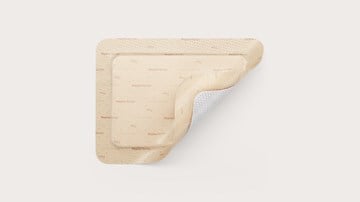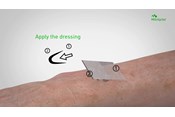Gentle wound contact layer
Mepitel One
One-sided wound contact layer that allows observation without removing the dressing
Mepitel® One is a gentle one-sided wound contact layer with Safetac® – the original less-pain contact layer with silicone adhesion. We designed it to mould softly to skin without sticking to the moist wound
Safetac also protects new tissue and intact skin – so wounds remain undisturbed to support faster natural healing
Mepitel One has a perforated design that lets exudate pass through to a secondary absorbent dressing. It enables easy delivery of topical treatments. And it allows secondary dressing changes without disturbing healing.
Mepitel One is adhesive on one side, so it’s easier for you to handle. Plus it’s transparent, so you can instantly assess healing progress without removing the contact layer.
- Transparent so you can instantly assess healing progress without removing the contact layer
- True undisturbed healing – it can remain in place for up to 14 days
- Safetac technology – minimising the risk of skin damage and pain to the patient
- Is cost-effective
- Suitable for a wide variety of indications
A recent multi-centre randomised controlled trial (RCT)
* A Visual Analogue Scale (VAS) score ≥30 mm was considered as clinically relevant pain
**UrgoTul is a registered trademark of Laboratoires URGO.
*** 100% re-epithelialisation
Further product information
When to use Mepitel One
Mepitel One is a wound contact layer designed for the management of a wide range of exuding wounds such as painful wounds, skin tears, skin abrasions, surgical incisions, partial thickness burns, traumatic wounds, blistering, lacerations, partial and full thickness grafts, leg and foot ulcers. It can also be used as a protective layer on non-exuding wounds and on areas with fragile skin.
The open structure of Mepitel One allows, where clinically indicated, topical ointments to pass through onto the wound.
It can be applied together with Mesorb®; or for high-exuding wounds with Mextra® Superabsorbent; with Tubifast® fixation; and also under compression bandages. Mepitel One can also be used in conjunction with Negative Pressure Wound Therapy (NPWT).
How to use Mepitel One
Watch how to easily apply Mepitel One.
Would you like to buy online Mepitel One?
Downloads
- Download Mepitel One Product Sheet (2.5 MB)
Product details
| Code | Size cm | Pcs/box | Pcs/case |
| 289100 | 5x7.5 | 10 | 70 |
| 289300 | 7.5x10 | 10 | 40 |
| 289500 | 10x18 | 10 | 70 |
| 289700 | 17x25 | 5 | 40 |
| 289750 | 27.5x50 | 2 | 14 |
Mölnlycke related products
'References'

 Mepitel One wound contact layer with Safetac technology
Mepitel One wound contact layer with Safetac technology














